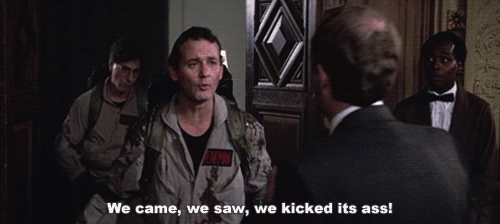Film companies today have begun resurrecting, recycling and reselling old-fashioned  franchises. An example of this is seen by the reboot of ‘The Ghostbusters’ (Columbia pictures; 1984). This is simply because it has been documented that these classical films are both “recognizable and iconic products rather than original, untested materials” (Proctor 2012, p.1). Therefore, the industry knows there is a mainstream audience out there for these types of films, and when considering that the materials had worked in the past, it is probable that it will make money again.
franchises. An example of this is seen by the reboot of ‘The Ghostbusters’ (Columbia pictures; 1984). This is simply because it has been documented that these classical films are both “recognizable and iconic products rather than original, untested materials” (Proctor 2012, p.1). Therefore, the industry knows there is a mainstream audience out there for these types of films, and when considering that the materials had worked in the past, it is probable that it will make money again.
Ghostbusters (Columbia Picture; 1984) was a world phenomenon that has been held as one of the greatest movies of all time. It had a spin-off cartoon show in the last 1980’s known as ‘The real Ghostbusters’ (American Broadcasting Company; 1986) which appealed to younger audiences whom might have found the films to scary at the time. This continued to help promote the film and increase the popularity of the text. However, in 2016 a remake of the original film lobbed the world into chaos with the new Ghostbusters (Columbia Pictures; 2016) starring comedic actors Melissa McCarthy, Kristen Wiig, Kate McKinnon, Leslie Jones and Chris Hemsworth. The film presented not only empowerment of feminism, but it also included many short cameos from the original film. This was not completely appreciated by consumers considering the remake had no narrative link to the previous films or TV series. This made audiences question whether the producers had just refurbished the film for profit or whether it should be held as part of the Ghostbuster empire.
Within this case study blog, we shall investigate and conclude whether the newest Ghostbuster (Columbia Pictures; 2016) should be accepted or rejected by audiences. To decide whether the remake should be accepted as an official part of the Ghostbuster trilogy, we will explore the use of Canon and how audiences can control what is accepted as being a part of an official text. The use of intertextuality is also another concept that plays a big part in this investigation as we look at what the director has chosen to include from the original movie in relation to the reboot. Considering the idea of market liberalism perspective which states that audiences have power over the media, we should contemplate whether without approval from the consumers, would such a film like the reboot of Ghostbusters face failure or not especially when it came to the box office. Looking at similarity and difference between what the producer have constructed from the original film into the newer version we can come to a conclusion of whether this remake should be classed as canon or not.
 However, before we dive into this investigation we must first establish the facts, which includes clarifying that although both movies were created by the same production company, Columbia pictures, they were directed by two different people and therefore the style of the movie was going to be unique to one another’s. Directors like to put their own signatures on their movies and subsequently we must look past the style of the film and focus on the content of the movie.
However, before we dive into this investigation we must first establish the facts, which includes clarifying that although both movies were created by the same production company, Columbia pictures, they were directed by two different people and therefore the style of the movie was going to be unique to one another’s. Directors like to put their own signatures on their movies and subsequently we must look past the style of the film and focus on the content of the movie.
 In the new 2016 Ghostbusters the gender table is turned and the character ‘Kevin’ is represented as a sex symbol especially seen in the scene ‘Let’s Go’ where Kevin hangs up an important phone call and then asks “Which one of these makes me look more like a doctor?” (Ghostbusters 2016) and the photos are shirtless pictures of him holding a stethoscope, one with glasses and the other without. The uses of these photo sexualized the character which is something the original film never tried to do.
In the new 2016 Ghostbusters the gender table is turned and the character ‘Kevin’ is represented as a sex symbol especially seen in the scene ‘Let’s Go’ where Kevin hangs up an important phone call and then asks “Which one of these makes me look more like a doctor?” (Ghostbusters 2016) and the photos are shirtless pictures of him holding a stethoscope, one with glasses and the other without. The uses of these photo sexualized the character which is something the original film never tried to do.






